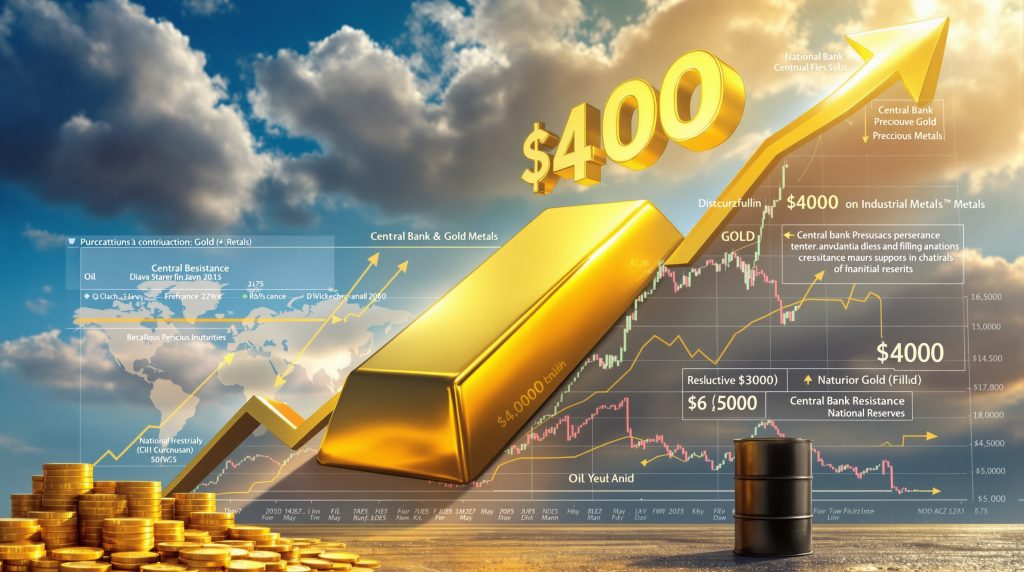What's Driving Gold's Historic Rally in 2025?
Gold has emerged as one of the standout performers in global markets this year, with prices surging approximately 46% year-to-date and approaching the psychologically significant $4,000 per ounce threshold. This remarkable rally represents gold's strongest annual performance since 1979, when the precious metal experienced similar dramatic gains amid high inflation.
The current gold rally is occurring against an unusual economic backdrop characterized by moderating inflation around 3% CPI rather than the double-digit inflation of the 1970s. This stands in stark contrast to historical gold all-time highs analysis that typically coincided with periods of severe economic distress or monetary chaos.
What makes today's market environment particularly puzzling is the combination of resilient equity markets (with the S&P 500 up approximately 15% year-to-date), extremely low stock market volatility (60-day S&P 500 volatility below 9%), and a consumer confidence index that recently hit a 5-month low—all while gold continues its relentless climb.
From a technical perspective, gold appears significantly extended above its long-term moving averages, with strong resistance anticipated at the $4,000 level and support established around $3,500 (April 2025 low). Most analysts expect the metal to consolidate between these levels in the near term as the market digests recent gains.
How Does Current Gold Performance Compare Historically?
When examined through a historical lens, the current gold rally stands out as truly exceptional:
| Time Period | Gold Performance | Notable Context |
|---|---|---|
| 2025 YTD | +46% | Approaching $4,000/oz, low inflation environment |
| 1979 | +126% | Double-digit inflation, geopolitical tensions |
| 2020 | +25% | COVID-19 pandemic, massive monetary stimulus |
| 2010-2011 | +44% | Post-financial crisis QE, sovereign debt concerns |
What makes the 2025 rally particularly unusual is its occurrence during a period of relatively moderate inflation (around 3%) compared to the double-digit inflation that characterized the 1979 rally. Today's gold market surge performance is happening without the obvious economic distress or monetary chaos that typically accompanies major gold bull markets.
Gold's Technical Position
From a technical standpoint, gold has reached an extended position with prices significantly above long-term moving averages. This technical stretching suggests caution for new buyers at current levels, though strong momentum could continue to carry prices higher in the near term.
The $4,000 level represents significant psychological resistance, while the April 2025 low around $3,500 has established itself as a key support level. Many technical analysts anticipate gold will consolidate between these levels in Q4 2025, potentially testing both extremes without necessarily breaking out decisively in either direction.
Why Are Investors Flocking to Gold Now?
The surge in gold investment represents a significant shift in market sentiment. After four consecutive years of outflows, gold ETFs have seen inflows increase by approximately 20% in 2025. This dramatic reversal indicates changing investor perceptions about economic risks and appropriate portfolio positioning.
Key factors driving investor interest include:
1. Political Uncertainty and Government Dysfunction
The looming government shutdown in Washington has heightened concerns about fiscal policy and governance stability. Gold traditionally performs well during periods of political uncertainty, as investors seek assets perceived to maintain value regardless of government actions.
Recent legislative gridlock and escalating partisan tensions have undermined confidence in fiscal policy coordination, pushing institutional investors toward gold as a hedge against political dysfunction.
2. Central Bank Purchasing
Central banks globally continue to accumulate gold reserves at a significant pace. This institutional buying provides a strong foundation for price support and reflects strategic diversification away from traditional reserve currencies.
According to World Gold Council data, central bank gold purchases have maintained a robust pace following record acquisitions in previous years, with particular activity from emerging market central banks seeking to reduce dependence on dollar-denominated assets.
3. ETF and Investment Inflows
After years of outflows, gold ETFs have seen substantial inflows in 2025, approaching levels last seen during the pandemic-driven rally of 2020. This shift in investment flows represents a major change in market sentiment and portfolio positioning.
Institutional investors have been particularly active in rebuilding gold positions, with some major funds increasing allocations by 5-10% compared to their 2024 positioning. Market analysts, including Bloomberg's Mike McGlone, have highlighted this institutional shift as a key driver of recent price action.
4. Geopolitical Tensions
Escalating conflicts in Europe and other regions have increased the appeal of gold as a traditional safe-haven asset during times of international instability. The uncertain geopolitical landscape has prompted wealth preservation strategies that favor gold's historical role as a crisis hedge.
What Does the Gold/Commodity Divergence Tell Us?
One of the most striking aspects of the current market environment is the divergence between gold and industrial commodities. While gold has surged, industrial metals and energy have underperformed:
| Commodity | YTD Performance (2025) | Market Signal |
|---|---|---|
| Gold | +46% | Safe haven demand |
| Silver | +60% | Mixed monetary/industrial signals |
| Copper | +20% | Lagging gold despite supply concerns |
| WTI Crude | -5% | Demand concerns, technological disruption |
This divergence suggests the market is simultaneously pricing in monetary uncertainty (benefiting gold) and economic growth concerns (pressuring industrial commodities).
The gold-to-oil ratio has reached approximately 61:1, meaning it takes 61 barrels of WTI crude to purchase a single ounce of gold. Historically, year-end ratios above 39:1 have only occurred twice—in 1933 and 2020—both periods marked by significant economic stress.
Market analysts suggest this extreme ratio indicates weak demand pull for crude oil (the world's most significant commodity) while showing strong demand for gold as an ancient store of value. This combination typically precedes periods of economic deceleration.
How Are Other Precious Metals Performing?
While gold has led the precious metals complex higher, other metals show interesting divergences:
Silver: The "Devil's Metal"
Silver has gained approximately 60% year-to-date, slightly outperforming gold. However, given silver's typical 2x volatility compared to gold, this relatively similar performance may signal caution. Silver trades between its industrial and monetary characteristics, currently caught between:
- Monetary demand pulling prices higher alongside gold
- Industrial demand concerns potentially limiting upside
- Support around $40/oz with potential to test $50/oz
The gold-to-silver ratio reached 105 in April (a historically high level), before moderating to around 82 currently. This compression indicates silver has been catching up to gold, but market observers note getting nearly the same performance at double the risk isn't necessarily a positive signal for the broader market.
Platinum and Palladium
These primarily industrial precious metals have underperformed gold significantly, reflecting:
- Concerns about automotive demand
- Substitution effects as relative prices shift
- Limited central bank buying compared to gold
The platinum-to-gold ratio reached its lowest level ever in May 2025, highlighting the significant divergence between monetary and industrial precious metals during this cycle.
Is This a Warning Signal for Equity Markets?
The current market configuration presents several concerning parallels to previous major market peaks:
-
Extreme Stock Valuations: The ratio of stock market capitalization to GDP is at levels comparable to 1929, suggesting potential overvaluation.
-
Gold Outperformance vs. Treasuries: Gold prices relative to Treasury bond prices are at their highest level since 1983.
-
Complacent Volatility: The VIX index remains low (around 16%) despite mounting economic and political uncertainties. The average for the year is running just below 20%.
-
Commodity Divergence: The stark performance gap between gold and industrial commodities often precedes economic slowdowns.
These factors suggest the possibility of a "profound reversion cycle" where current market extremes normalize, potentially triggering significant volatility in Q4 2025 and beyond.
Market strategists note that for the current bullish market configuration to continue, stock market volatility would need to remain at 5-year lows—an increasingly difficult proposition as we enter the traditionally volatile fourth quarter.
How Might Gold Perform in Different Economic Scenarios?
Gold's future performance will likely depend on how broader market conditions evolve:
Scenario 1: Continued Market Stability
If equity markets remain resilient and volatility stays low:
- Gold could pull back to the $3,400-3,500 range
- Still representing a strong annual gain of 30%+
- Limited upside beyond current levels
In this scenario, gold might trade sideways to slightly lower as extreme positioning unwinds, but would still finish the year with one of its strongest performances of the past century.
Scenario 2: Market Volatility Increases
If equity market volatility picks up (VIX moving from current 16% toward 20%+):
- Gold could test the $4,000 level more decisively
- Potentially leading to a period of consolidation
- Setting the stage for further gains if economic conditions deteriorate
A modest uptick in volatility could validate gold's recent strength and potentially trigger additional safe-haven flows.
Scenario 3: Significant Market Correction
In the event of a meaningful equity market correction:
- Initial gold selling pressure possible as investors raise liquidity
- Similar to 2008 when gold initially fell 20% during market stress
- Followed by potential strong recovery as monetary response unfolds
Historical precedent suggests gold could initially fall during a liquidity event before recovering strongly as policy responses take effect. During the 2008 financial crisis, gold dropped approximately 20% in the initial phase before staging a powerful recovery.
What About Bitcoin and Digital Assets?
Bitcoin and other digital assets present an interesting contrast to gold in the current environment:
- Bitcoin currently trades around 29.5 ounces of gold per BTC
- Historical high was 40 ounces (following 2016 U.S. election)
- 2025 low was 25 ounces
Unlike gold, cryptocurrencies have demonstrated strong correlation with risk assets:
- 48-month correlation with equities at record highs (approximately 0.6)
- In 2020, this correlation was negative
- Performance year-to-date significantly lags precious metals (+10-20% vs. +50%)
This suggests cryptocurrencies may be more vulnerable than gold to potential equity market weakness, despite narratives positioning them as inflation or monetary debasement hedges.
Market strategists point out that while Bitcoin had a negative correlation to equities in 2020, it now shows the highest correlation to the stock market in its history. This shift in market dynamics suggests cryptocurrencies currently function primarily as risk-on assets, unlike gold's traditional risk-off characteristics.
What Should Investors Watch in Q4 2025?
As markets enter the traditionally volatile fourth quarter, several key indicators bear watching:
-
S&P 500 Volatility: Any sustained move in the VIX above 20% could signal the beginning of a broader market adjustment.
-
Bitcoin/Gold Ratio: A break below 25 ounces of gold per Bitcoin would suggest deteriorating risk appetite.
-
Treasury Bond Performance: A potential beneficiary of market stress, with yields potentially moving lower after an extended period of pressure.
-
Gold/Copper Ratio: Further divergence would reinforce concerns about economic growth prospects.
-
Central Bank Policy Responses: Any shifts in monetary policy stance could significantly impact gold's trajectory.
Market observers note that the fourth quarter will be particularly telling for setting the tone of market dynamics potentially lasting years. A modest pickup in volatility could trigger significant market repricing across asset classes.
Investment Implications: Positioning for Uncertainty
Given the current market configuration, investors might consider:
-
Maintaining Gold Exposure: While gold approaching $4000 an ounce appears extended in the near term, it continues to offer portfolio diversification benefits in an uncertain environment.
-
Cautious Approach to Industrial Metals: Despite supply disruption narratives, industrial metals face potential headwinds if economic growth concerns intensify.
-
Treasury Bond Consideration: After years of underperformance, government bonds may offer both yield and potential capital appreciation if market volatility increases.
-
Reduced Risk Asset Exposure: The combination of extended valuations and gold's warning signal suggests prudence regarding equity and cryptocurrency allocations.
-
Volatility Protection: Strategies that benefit from increased market volatility may offer asymmetric return potential given current low VIX readings.
The extreme gold-to-oil ratio (61:1) suggests caution is warranted across markets, as historically such extremes have only occurred during periods of significant economic stress (1933 and 2020). Recent record-breaking gold prices have been accompanied by growing institutional interest, as highlighted in recent ABC7 News coverage of the market's dynamics.
Gold's Message to Markets
Gold's approach toward $4,000 an ounce sends a powerful signal to global markets. While interpretations vary, the precious metal's historic $3000 surge explained by analysts suggests investor concern about underlying economic and monetary conditions.
The divergence between gold and industrial commodities further reinforces this cautionary message. Whether gold's warning proves prescient or premature remains to be seen, but prudent investors should consider its implications for portfolio positioning as markets navigate an increasingly complex macroeconomic landscape.
As we enter the final quarter of 2025, markets appear poised at an inflection point, with gold potentially serving as the canary in the financial coal mine. The gold price forecast 2025 indicates that the coming months may well determine whether current market extremes represent a new paradigm or the precursor to a significant adjustment across asset classes.
Disclaimer: This analysis contains forward-looking statements about financial markets and asset prices. Future market conditions may differ significantly from those anticipated. Investors should conduct their own research and consult with financial advisors before making investment decisions.
Want to Profit from the Next Major Mineral Discovery?
Discovery Alert's proprietary Discovery IQ model instantly notifies investors about significant ASX mineral discoveries, turning complex data into actionable insights for both short-term traders and long-term investors. Visit our discoveries page to understand how historical mineral discoveries have generated substantial returns, and begin your 30-day free trial today.




